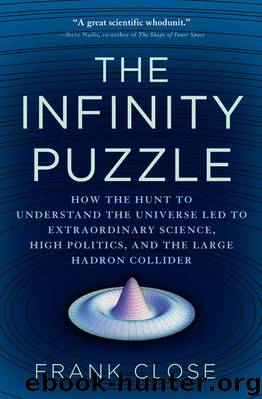The Infinity Puzzle by Frank Close

Author:Frank Close
Language: eng
Format: mobi, epub
ISBN: 9780307399830
Publisher: Knopf Canada
Published: 2011-11-29T06:00:00+00:00
’t Hooft looked at the case when all particles were massless. Many among the cognoscenti believed the massless Yang-Mills theory to be renormalizable, but ’t Hooft felt that no one had actually proved the fact.27 He completed the first draft of a proof at the end of 1970 or early in 1971.
Veltman was working in Paris that year and visited Utrecht several times. ’t Hooft felt it was hard to get Veltman’s attention. ’t Hooft’s memory is that he had “big fights with Veltman,” who was not convinced that ’t Hooft had gotten any further than he himself had earlier.28 Veltman was right: ’t Hooft had shown that there was no problem with infinity, but had not shown that the total chance of something happening came out as 100 percent; in the jargon, he had not “satisfied unitarity.” In effect, he had not proved that the theory contained only physical particles and not ghosts. ’t Hooft eventually managed to get rid of the ghosts, but Veltman was still not convinced. He was worried that “anomalies” lurked within the calculations. If there are anomalies, a theory is not gauge invariant and, hence, is wrong. The anomaly problem was more difficult, but ’t Hooft eventually satisfied Veltman of this, too.29 His paper, which was the first explicit demonstration that massless Yang-Mills theories are renormalizable, appeared in 1971.30 Veltman thought that although “it was perhaps not earth-moving, his path integral manipulations were nice and useful.”31 As we have seen, and Weinberg also remarked, it would be this technique that proved seminal in ultimately making the breakthrough.
This was fine for a warm-up exercise, but said nothing about the real challenge: What happens with massive particles? Veltman had spent so long on trying, and failing, to find a renormalizable theory with massive electrically charged W bosons that he was becoming convinced that it couldn’t be done. That was until one day in 1971 when they had a memorable conversation.32
’t Hooft was excited at having solved the problem for the case when everything was massless, but Veltman tried to dampen his enthusiasm by reminding him of the real challenge, which involved massive particles. Veltman then guided ’t Hooft by saying, “All you need is just one example [of such a theory with massive particles] that is renormalizable.” Once that was done, Veltman told him, some “freak” who likes building models could fix it to look like the real world.
Veltman was saying these things rhetorically, convinced that it was impossible, but ’t Hooft replied, “I can do that.” Veltman stopped and said, “What?” to which ’t Hooft repeated, “I can do that.” ’t Hooft’s memory33 is that Veltman later recalled the occasion thus: “We were having a walk, and at that moment I nearly bumped into a tree.” Veltman today recalls it more soberly as, “Write it down and we shall see.”34
’t Hooft explained that he had identified a missing ingredient in Veltman’s previous unsuccessful attempts. ’t Hooft’s inspiration from Cargese had been the role that the sigma and Bose condensation played in the renormalizability of the pi-sigma model.
Download
This site does not store any files on its server. We only index and link to content provided by other sites. Please contact the content providers to delete copyright contents if any and email us, we'll remove relevant links or contents immediately.
The Complete Stick Figure Physics Tutorials by Allen Sarah(6638)
Secrets of Antigravity Propulsion: Tesla, UFOs, and Classified Aerospace Technology by Ph.D. Paul A. Laviolette(3450)
Thing Explainer by Randall Munroe(3328)
The River of Consciousness by Oliver Sacks(2992)
The Order of Time by Carlo Rovelli(2714)
I Live in the Future & Here's How It Works by Nick Bilton(2524)
How To by Randall Munroe(2475)
A Brief History of Time by Stephen Hawking(2473)
The Great Unknown by Marcus du Sautoy(2186)
What If?: Serious Scientific Answers to Absurd Hypothetical Questions by Randall Munroe(2170)
Blockchain: Ultimate Step By Step Guide To Understanding Blockchain Technology, Bitcoin Creation, and the future of Money (Novice to Expert) by Keizer Söze(2137)
Midnight in Chernobyl by Adam Higginbotham(2078)
Networks: An Introduction by Newman Mark(1998)
The Meaning of it All by Richard Feynman(1909)
Easy Electronics by Charles Platt(1864)
The Tao of Physics by Fritjof Capra(1850)
When by Daniel H Pink(1777)
Midnight in Chernobyl: The Untold Story of the World's Greatest Nuclear Disaster by Adam Higginbotham(1775)
Introducing Relativity by Bruce Bassett(1754)
